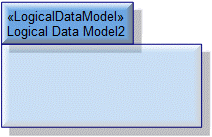Logical data model (UPDM - DoDAF aliases)

Creation
To create a Logical Data Model:
• From the model or a UML Package: right-click the Package, point to New, point to DoDAF, point to Operational, and then click Logical Data Model.
• From an Architectural Description or Service Description or Logical Data Model: right or Service Description-click the element, point to New, point to DoDAF, point to Operational, and then click Logical Data Model.
• From a DIV-2 Information Model: click the  Logical Data Model button, and then click in free space on the diagram.
Logical Data Model button, and then click in free space on the diagram.
 Logical Data Model button, and then click in free space on the diagram.
Logical Data Model button, and then click in free space on the diagram.Appearance
When shown on a DIV-2 Information Model, a Logical Data Model appears as follows:

Relationships
There are no relationships that are of significant importance to a Logical Data Model.
The following sections provide information about how a Logical Data Model is used in the model.
Create a Logical Data Model from
•  UML Model
UML Model
 UML Model
UML Model•  UML Package
UML Package
 UML Package
UML PackageCreate from a Logical Data Model
In addition to the UPDM elements that can be created from all UPDM elements (Representation, Definition, Information, and Metadata):
Shown on these diagrams, tables and matrices
In addition to the AV-2 Integrated Dictionary and StdV-1 Standards Profile, which can show all UPDM elements:
UPDM writeable properties
The following writeable properties are available on the Logical Data Model tab of a Logical Data Model element's Property Pages:
• URI





